- Home
- Kathy Reichs
The Bone Code Page 4
The Bone Code Read online
Page 4
Ten minutes later, a young man approached, bony arms dangling from the sleeves of scrubs at least one size too large. His skin was blotchy, his hair so thin it made the wig lady’s arrangement look good.
“Dr. Brennan?” His name tag said Brian.
“Yes.”
“Follow me. I’ll take you to the second floor.”
I did. He did.
“Ladies change in there.” Hooking a thumb at one of several doors along the hall. “Scrubs are on shelves to the left.” More thumb. “Autopsies there.”
Thanking Brian, obviously a man of few words, I entered a small room with lockers lining the walls and forming rows in the middle. A metal bench ran down the center of each subdivided area.
The scrubs were located as promised. I found a set in size small, changed from my street clothes, and headed out.
Passing what I assumed were staff offices, I entered where Brian had indicated and found myself in the heart of the operation. Surrounding me were an elevator for direct access to the morgue one floor down, a viewing area, a main autopsy room, and a smaller autopsy room, possibly for decomp and other malodorous cases.
Stepping into the viewing area, I assessed the space in which I’d be working. Noted stainless-steel tables, roll carts, countertops, sinks, and hanging scales. Multidrawered cabinetry. Adjustable high-intensity lights. Painted concrete flooring generously outfitted with drains. The same setup I’d seen dozens of times.
In addition to Brian, two people were present, one of each gender. The woman, dressed in navy blazer, white polo, and khaki chinos, stood off by herself, thumbs hooking her belt, eyes roving the room. Roughly six feet tall, with mahogany skin and sage-green eyes, she looked like she’d emerged from preschool a cop.
The man was hunched down, observing something on a computer screen. With elephant ears, a beak nose, and bulging Adam’s apple, he resembled the cartoon version of Ichabod Crane, only older, taller, and thinner.
A prebreakfast cyber search had revealed that MUSC has five pathologists on faculty, among them one Walter Carl Klopp. I assumed Ichabod was Dr. Klopp.
Klopp’s scrubs suggested he’d already been cutting. Blood smeared the right half of his chest, and a kumquat-shaped splotch darkened one sleeve.
Each of the two tables held a body bag. The contents on the left looked considerably more substantial than those on the right.
Deep breath.
Odor carried outward as I pushed through the swinging stainless-steel door, an acrid-sweet mix of refrigerated flesh, putrefaction, and disinfectant. And a touch of something else. Something briny and pungent that triggered images of the sea.
Three heads swiveled my way. Klopp smiled. The cop did not.
“Dr. Brennan, I presume.” Klopp’s mask was off and bunched in one hand. “Herrin says we’re to treat you like royalty.”
“I hope I can be of use,” I said.
“Walter Klopp.” Doing that two-finger salute thing some men find cool. “Walt.”
“Tempe,” I said, pleased that Klopp hadn’t offered to shake.
Klopp turned toward the woman. “Detective Vislosky is with the Charleston PD.”
Vislosky nodded.
I nodded.
“Just finished a medical autopsy.” Did Klopp feel compelled to explain his untidy scrubs? “A capno case.”
I must have looked confused.
“Capnocytophaga.” Klopp chin-cocked the screen he’d been viewing. “Have a look. You don’t see it every day.”
Curious, I crossed to him.
The image showed a corpse on a table identical to the pair behind us. Its trunk and skull gaped empty. Its organs lay divided between a hanging scale and a cork cutting board.
“The poor bastard was infected by his own cockapoo.”
I wasn’t sure what that meant but was clear on one thing. The poor bastard had met a most unpleasant end. One leg, amputated at the knee, showed surgical scarring but little healing on the stump. The surviving foot and every finger were black as creosote. Scaly patches covered the man’s forehead, lips, and cheeks, and a yawning triangle was all that remained of his nose.
I made a note to myself to read up on capno. And to avoid it. Cockapoos?
“Let’s start with externals on both.” Klopp spoke to Brian, indicating Herrin’s container victims. “Get an overall sense of the situation.”
Vislosky watched as Brian, Klopp, and I gloved and masked. Added aprons and goggles for extra protection.
When we were ready, Klopp gave a thumbs-up.
Upon arrival at the morgue, each victim had been assigned a case number indicating that the autopsy was forensic in nature. Brian started with the body bag showing the larger bulge, AF21-986. The whrrrp of the zipper sounded like a scream in the silence.
He crossed to AF21-987.
Another scream.
Vislosky kept her distance.
I stepped close.
5
THURSDAY, OCTOBER 7
It was déjà vu.
Same sky-blue polyethylene sheeting. Same poppy-red electrical wire. Same parrot-green Chlorophyta algae. Same stone-gray polypropylene bin bearing a faded orange label.
Same multicolored skull.
A rainbow déjà vu.
After stumbling upon the container and prying it open, the kayakers had put some effort into tugging at the plastic sheet wrapping the uppermost body. Herrin had cut some wire and a bit more plastic to confirm that the body was human. And the ocean had taken its toll.
Klopp directed Brian to further unwrap the skull of AF21-986 as much as possible without cutting. His efforts exposed half the face. The orbits stared empty and wide, as though startled at the sudden exposure to light.
Below the head, hints of algae-coated bone could be seen through tears in the plastic. A toothless section of mandible. Three proximal phalanges truncated at mid-shaft. A slimy pelvic rim.
Things had gone slightly better for AF21-987, the lower-down and smaller of the two victims. There the macabre packaging had remained largely intact.
Herrin had supplied everything I’d requested. While I arranged equipment on a countertop—I’m finicky about placement—Klopp shot video of the remains.
Bone saw. Calipers. Magnifier. Forceps. Tweezers. Dental picks. Soft bristle brushes in graduated sizes. Toothbrush. Specimen-collection vials.
Finally, I flipped through an array of charts and diagrams, chose several, and snapped them onto a clipboard.
When I turned, Klopp was setting down the camera.
“Did you get that?” I pointed to the fifty-gallon bin dripping muddy seawater onto a tarp in one corner. Brought here at my request.
Wordlessly, Klopp crossed and began recording more footage. After labeling two vials, I joined him, a hollowness blossoming in my chest.
“The lettering’s toast.” Klopp was hunched as before, this time for close-ups. Given his height, it was quite a hunch.
“It’s a biohazard warning,” I said. “For medical waste.”
“I’ll be damned. You can read that?”
“Film the rocks in the bottom.”
“Bastard weighted the thing down to sink.”
As with the Montreal vics.
I indicated several patches of encrustation on the container’s inner and outer surfaces. “Shoot the barnacles, then I’ll collect samples.”
“Why?”
“They might be useful for determining when the container went into the water. Maybe where, if you get extraordinarily lucky.”
In my peripheral vision, I sensed the first glimmer of interest from Vislosky. Unhooking her thumbs, she straightened and watched closely as I detached a number of the tiny, stalk-like crustaceans, divided the collection, and sealed each half into a separate vial.
Intent eyes followed me back to the counter. When my gaze met hers, one penciled brow cocked up ever so slightly.
“Or they might not,” I said.
Vislosky said nothing.
An autopsy rarely provides the drama depicted in some crime fiction. Uncommon is the great Aha! moment when the microscopic scale of an extinct Patagonian reptile is tweezed from the victim’s inner ear. The goals, as with any scientific endeavor, are threefold: accuracy, precision, and documentation.
The protocol is specific, the process tedious.
Klopp and I discussed strategy. Agreed. He would focus on soft tissue. I would focus on bone. My task would turn out to be more taxing than his.
Odor swelled as Brian, Klopp, and I eased each bundle from its body bag. The noxious cocktail of rotting algae, sea creatures, and human flesh burned my eyes and forced me to breathe through my mouth.
AF21-986 made a wet thunk sliding onto the stainless steel. AF21-987, feather-light, made almost no sound. Both corpses had been curled tight in order to stuff them into the container.
As Klopp shot more video and I made notes, Brian manned the wire cutters. Twenty minutes of snipping and peeling resulted in our first unobstructed view of the remains.
You might think that sinking deep below the waves would be a good way to avoid all that nasty postmortem decomp business. You’d be wrong. A corpse in the ocean is subjected to a variety of physical and biological forces, all committed to recycling the body’s molecules back to nature. Temperature, salinity, currents, depth, and the nature of the substrate all affect how long the process takes. As on land, many creatures play a role.
Marine animals are as opportunistic as their terrestrial counterparts. Fish and eels will scavenge. Arthropods, especially the large ones like lobsters, shrimp, and crabs, are experts at opening up a body. Mollusks, many of which normally dine on algae, will happily switch to carrion. Echinoderms such as sea stars, sand dollars, sea urchins, and sea cucumbers will belly up to flesh if given the chance.
And there are the aforementioned barnacles. These and other sessile invertebrates don’t so much feed on remains as attach to them.
The polypropylene bin had survived immersion better than a metal one might have but had failed in its promise of a watertight seal. Degraded and warped, the lid had allowed the inflow of salt water and invasion by a variety of species.
And that invasion had kicked the recycling circus into high gear.
I yielded first access to Klopp, waited while he surveyed each set of remains. Watching him bend to the task, I couldn’t help but think of a praying mantis. Finally, he straightened and turned to me.
“Seems this will be your show, Dr. Brennan.” Shaking his head. “No brain, no organs, nothing but bones. Not sure if that pleases me or not.”
“Perhaps you could sift through the contents of the bin? Continue shooting video?”
“I’m happy to do that. Actually, I wouldn’t mind observing while you work. Maybe I can pick up a few tricks.”
“Of course.” I hate having anyone look over my shoulder.
I started with AF21-986. Though completely skeletonized, due to the tightness of the plastic shroud, the major segments of the body had remained in rough anatomical position. The small bones of the hands and feet, not so much.
“Why so splotchy?” As I was disentangling and rearranging skeletal elements, Klopp was filming the red, green, and blue mottling on the skull.
“Algae.”
“What’s that?” Zooming in on a series of coiled carbonate tubes on the frontal and parietal bones.
“Probably some sort of sea worm.”
“And the little craters?” Klopp was asking about a cluster of small, round pits on the left parietal and temporal bones.
“Snail rasping.”
“Snails?” Skeptical.
“Except for the bivalves—”
“Clams, mussels, oysters, the good-eating critters?”
“Yes. Except for them, all mollusks—think whelks, periwinkles, slipper snails—have chitinous teeth that are very efficient at grating on bone. But I’m not a marine biologist.”
“ ’Course you’re not.” Klopp resumed filming. “Got one bullet entrance at the back of the skull. Looks like she was shot from behind.”
I didn’t agree or disagree.
“Teeth are history. Suppose they fell out postmortem?”
“I doubt it.” I knew I’d find microfracturing on the mandible and maxilla. Didn’t say so.
“Either way, they’re gone. Ditto the fingers. Maybe snipped off with pruning shears? We’ve had some luck nailing tool type from patterning on the cut surfaces. You done any of that, maybe with dismemberment cases?”
Focused on my task, I nodded absently.
Klopp shot a bit more footage, then moved to the other table.
I continued my reconstruction, paying particular attention to cranial and pelvic features and to the state of the long bones and clavicles. By the time I’d finished, I had a sense of the victim.
And the mantra was again battering my brain.
It can’t be.
It can’t be.
“Got some tissue on the foot and ankle on this one. Might yield DNA.”
I crossed to AF21-987.
Klopp was right. Remnants of ligament and cartilage lingered at the major joints, and a swath of putrefied skin and muscle overlay the left tarsals and metatarsals.
“Looks like we’ve got some fibers stuck to the underside of the zygomatic.”
Before I could respond, Klopp had picked up forceps and begun tweezing threads from the back of the right cheekbone. I marked a vial and handed it to him.
When he returned it, sealed, I held it up to the light.
“I think these are hairs,” I said.
“Might be,” he agreed, squinting at the vial, then shaking his head. “Don’t folks do the damnedest things?”
The hairs, short and curly, were dark at the roots, cotton-candy pink throughout the shafts.
I snapped a shot, then made a note on my form.
“This one’s smaller than the one over there.” Klopp stated the obvious. “Herrin had it pegged as a kid. I’m not so sure. Too bad we’ve got no teeth for aging.”
I didn’t respond. My eyes were roving over the bones. The cranial sutures. I picked up a clavicle. The skull. An innominate—one of the fused bones of the pelvis.
“Looks like the left foot got twisted backward, then held in place inside the plastic,” Klopp went on.
“This one went into the container first. Then she”—I indicated AF21-986—“was forced in on top of her. That positioning provided some protection.”
For the first time that day, Vislosky spoke. “She?”
I nodded.
“How do you know?” Klopp asked.
“Mostly the pelvis.”
“Show me.” Klopp circled the table.
Vislosky strode over to us.
Crap.
Mine was going to be a very long day. Not in the mood for an anatomy lesson, I decided to skim through it quickly.
While rotating the innominate of AF21-986, I described features, using common terminology and profoundly oversimplifying. “Broad, flaring hip area on the upper portion. Long pubic element and wide subpubic angle in front. Broad sciatic notch.” I demonstrated the breadth of the last by inserting and wiggling my thumb.
“You can tell from just that bone?” Vislosky sounded grudgingly interested.
I swapped the pelvis for the cranium. “The skull’s also important. Note the smooth muscle attachments, small mastoid processes and brow ridges, and sharp upper orbital margins.” Pointing to each.
“Any thoughts on age?” Klopp asked.
“They’re both young,” I said.
“How young?” Vislosky asked.
I retrieved the innominate and pointed to the pubic symphysis, the point at which that pelvic half would have met its counterpart in life. “See how rippled this surface looks? That tells me young.”
I turned the bone to show the curving upper rim of the hip blade.
“Rippled,” Klopp said.
“Bingo,” I said. “A crest of bone fuses on
to that surface between the ages of fifteen and twenty-two in girls. These are very broad and very rough estimates. Anyway, it’s not there.”
I swapped the innominate for a clavicle. “This is a collarbone. See how one end is rippled?” Vislosky and Klopp nodded, never raising their eyes. “A tiny cap of bone called an epiphysis fuses onto that end during the late teens or early twenties in girls, sometimes later. It’s not there.”
I switched the clavicle for a femur. “This is the thigh bone.” I pointed to a large knob at one end. “That’s the femoral head. See that line?” Again, the nods. “That tells me that the epiphysis is in the process of fusing but hasn’t finished. That fusion takes place between the ages of thirteen and seventeen for most girls.”
“She was in her mid-teens.” Vislosky got it.
“Probably,” I said.
Thumb jab at AF21-986. “And that one?”
“A little older.”
Vislosky shot me a gimme a break look.
As Ryan pointed out, I despise being pressured.
“I dislike drawing conclusions until I’ve completed my analysis.”
“Do it anyway,” Vislosky said.
I didn’t respond.
“Nothing you say will leave this room?” Klopp said, leveling a meaningful glance at Vislosky.
“What am I, Fox News?” she snapped.
“Knowledge of descriptors will help Detective Vislosky begin her investigation,” Klopp said to me, trying to defuse the tension.
I started to object. Vislosky cut me off.
“Look, some asshole capped these two, clipped their fingers, then deep-sixed them in the Atlantic. You’re saying this one was a kid.” Indicating the bones at her elbow. “That makes me want to net said asshole and put his nuts in a vise. The sooner I can float profiles and search MP files, the sooner I can figure out who these two are. Which is step one in nailing the fuckwad who killed them. Comprendo?”
Offensive as her tone was, she had a point.
“As I said, your vics are both female. This one was probably fifteen to seventeen.” Indicating the near table. “That one was a few years older.”

 Two Nights
Two Nights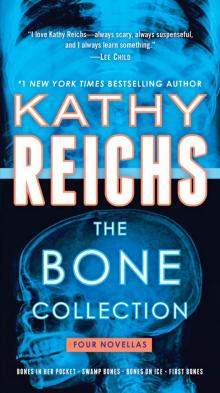 The Bone Collection: Four Novellas
The Bone Collection: Four Novellas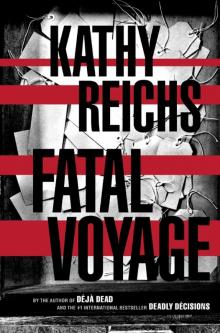 Fatal Voyage
Fatal Voyage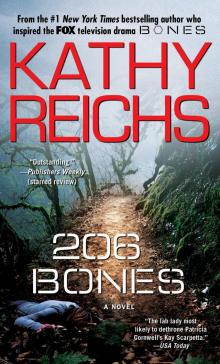 206 Bones
206 Bones Bones to Ashes
Bones to Ashes Terminal
Terminal Monday Mourning
Monday Mourning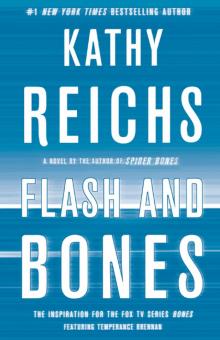 Flash and Bones
Flash and Bones Cross Bones
Cross Bones Devil Bones
Devil Bones Break No Bones
Break No Bones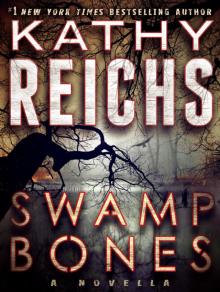 Swamp Bones
Swamp Bones Déjà Dead
Déjà Dead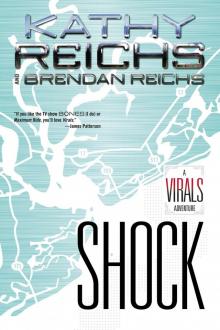 Shock
Shock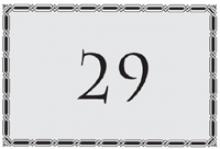 Spider Bones
Spider Bones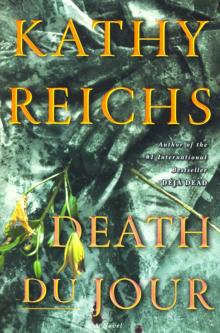 Death Du Jour
Death Du Jour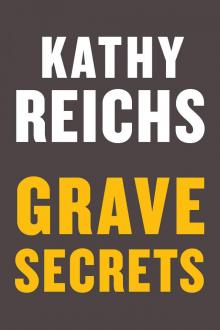 Grave Secrets
Grave Secrets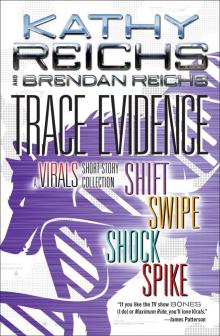 Trace Evidence: A Virals Short Story Collection
Trace Evidence: A Virals Short Story Collection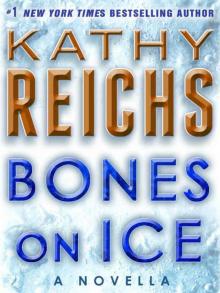 Bones on Ice
Bones on Ice The Bone Code
The Bone Code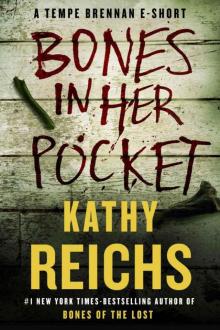 Bones in Her Pocket
Bones in Her Pocket Seizure:
Seizure: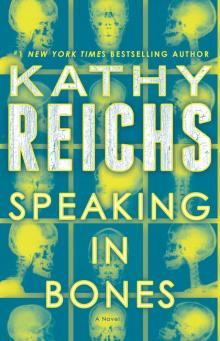 Speaking in Bones
Speaking in Bones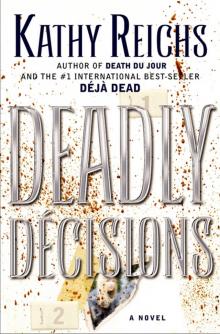 Deadly Decisions
Deadly Decisions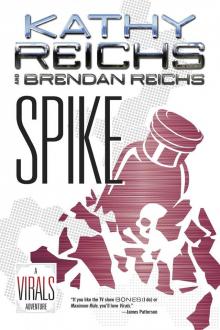 Spike
Spike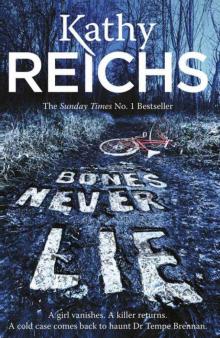 Bones Never Lie
Bones Never Lie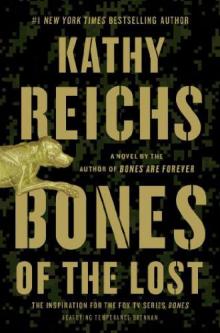 Bones of the Lost
Bones of the Lost Virals 03.5 - Swipe
Virals 03.5 - Swipe Exposure
Exposure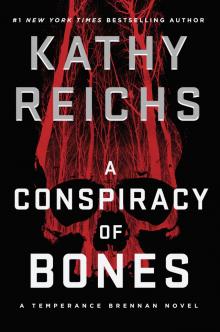 A Conspiracy of Bones
A Conspiracy of Bones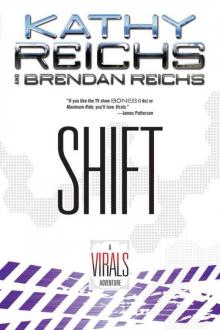 Shift (tory brennan)
Shift (tory brennan)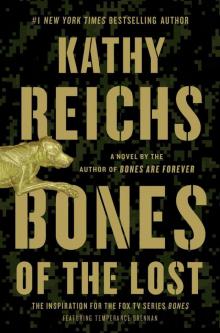 Bones of the Lost: A Temperance Brennan Novel tb-16
Bones of the Lost: A Temperance Brennan Novel tb-16 Virals tb-1
Virals tb-1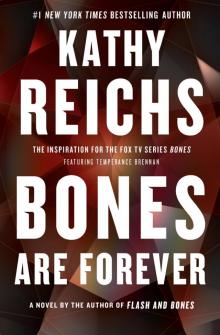 Bones Are Forever tb-15
Bones Are Forever tb-15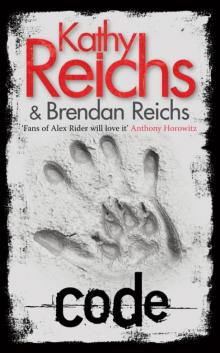 Code tb-3
Code tb-3 Seizure tb-2
Seizure tb-2 Deadly Descisions
Deadly Descisions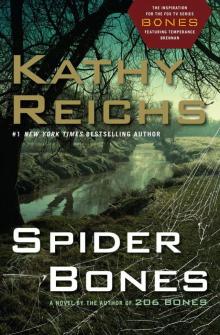 Spider Bones: A Novel
Spider Bones: A Novel